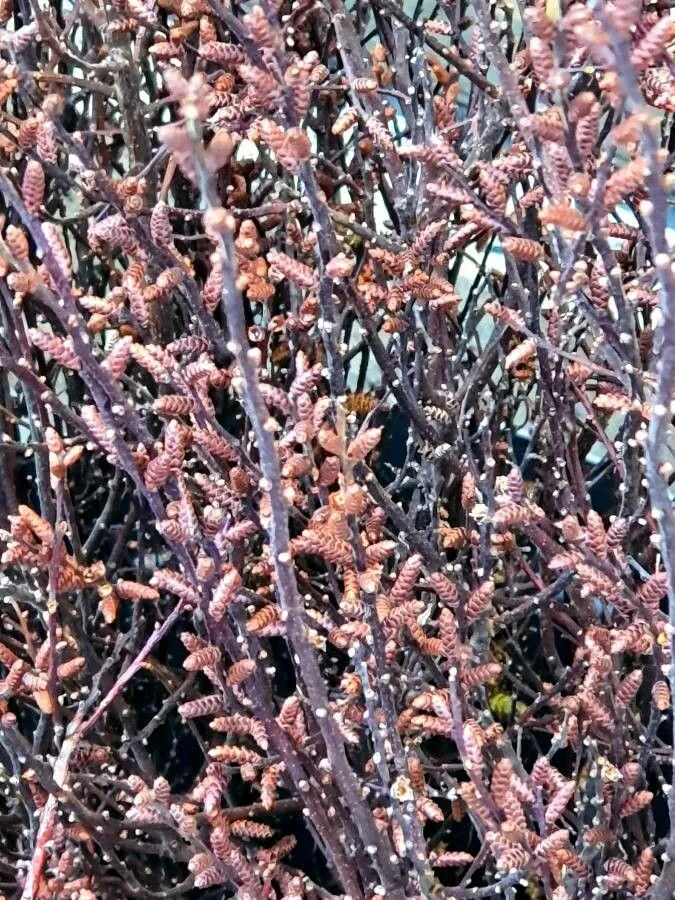
Author: L.
Bibliography: Sp. Pl.: 1024 (1753)
Year: 1753
Status: accepted
Rank: species
Genus: Myrica
Vegetable: False
Observations: Russian Far east to N. & NC. Japan, Subarctic America to N. & EC. U.S.A., W. & N. Europe
Bog-myrtle, scientifically known as Myrica gale, is a deciduous shrub that has piqued the interest of botanists and plant enthusiasts for centuries. Described in the seminal work “Species Plantarum” by Carl Linnaeus in 1753, this plant is renowned for its wide-ranging habitat and distinctive aromatic properties.
Bog-myrtle is distributed across various parts of the globe, flourishing from the cold reaches of the Russian Far East and subarctic regions of America to the northern and east-central parts of the United States. It also extends its range to Western and Northern Europe, highlighting its adaptability to diverse climates and soil conditions. While usually located in wetlands, bogs, and marshy areas, this plant is well-known for its resilience and ability to thrive in areas with acidic soils.
As a member of the Myricaceae family, Bog-myrtle is closely related to other aromatic shrubs and trees. It typically grows to a height of 1-2 meters with slender branches and leaves that emit a fragrant scent when crushed. The leaves are oblong with a slightly toothed margin, making the plant easily identifiable. In late spring to early summer, it produces small, inconspicuous flowers that are usually yellow to greenish in color, arranged in dense clusters. These flowers eventually give way to fruit, which are small nutlets covered in waxy glands.
Historically, Bog-myrtle has been utilized for various purposes. In traditional herbal medicine, it has been valued for its anti-inflammatory and antiseptic properties. Moreover, the aromatic leaves have been used to flavor beverages and beers, lending a distinctive taste that was particularly popular before the widespread availability of hops.
With its historical legacy and ecological significance, Bog-myrtle remains an intriguing plant worth studying and preserving. Its wide habitat range and cultural relevance underscore its importance in both natural and cultural histories.
Eng: bog-myrtle, meadow-fern, sweet gale, sweetgale, bog-myrtle, sweet gale, bog myrtle, sweet bayberry
Deu: gagel, gagelstrauch, post
Dan: mose-pors, pors
Fra: bois-sent-bon, myrique baumier, piment royal, myrice baumier, myrice galé
Lav: parasta purvmirte
Swe: pors, suomyrtti
Nob: pors
Nno: pors
Nor: pors, post
Fin: suomyrtti
Nld: wilde gagel
Sme: riddorissi, sarvvarissi
Cym: bwrli, cwrli, gwrddling, gwrling, gwyrddling, helygen fair, madrwydd, madywydd, madywydd bêr, mordywydd, myrtwydd y gors
Gla: còinneach dhearg, roid, roidean
En: Bog-myrtle, Meadow-fern, Sweet gale, Sweetgale, Bog-myrtle, sweet gale, Bog Myrtle, Sweet bayberry, Bog Gale, Dutch Myrtle, Moor Myrtle
Be: Васкоўнік звычайны
Ca: Murta de Brabant
Da: Pors, Mosepors, Mose-pors
Nl: Wilde gagel, Gewone Gagel
Et: Harilik porss
Fi: Sahasuomyrtti, Suomyrtti
Fr: Bois-sent-bon, Myrique baumier, Piment royal, Myrice baumier, Myrice galé, Galé odorant, Piment aquatique, Lorette, Myrte bâtard, Myrte des marais, Poivre du Brabant, Romarin du nord
Gl: Frundo
De: Gagelstrauch, Gagelsrauch, Gagelstauch, Moor-Gagel, Torf-Gagel, Gagel, Post, Sumpfmyrte
Hu: Fenyérmirtusz
Is: Mjaðarlyng
Ga: Raideog
It: Myrica
Lv: Parastā purvmirte, Parasta purvmirte
Lt: Pajūrinis sotvaras
Ml: മിറൈക ഗെയ്ൽ
Se: Riddorissi, Sarvvarissi
No: Pors, Post
Nb: Pors
Nn: Pors
Pl: Woskownica europejska
Ru: Восковница обыкновенная
Gd: Roid, Còinneach dhearg, Roidean
Es: Arrayan de los pantanos, Mirto de Brabante
Sv: Pors, Suomyrtti
Uk: Мірика звичайна
Cy: Gwyrddling, Bwrli, Cwrli, Gwrddling, Gwrling, Helygen Fair, Madrwydd, Madywydd, Madywydd Bêr, Mordywydd, Myrtwydd y Gors
Taken Jan 1, 1900 by EOL − Encyclopedia of Life (cc-by-nc)
Taken Mar 27, 2021 by Hans van Vugt (cc-by-sa)
Taken Jul 28, 2019 by Charles Buddendorf (cc-by-sa)
Taken Mar 8, 2022 by Martin Bishop (cc-by-sa)
Taken Aug 19, 2020 by CarolinaHelena (cc-by-sa)
Taken Mar 15, 2021 by Heather Hoaglund-Biron (cc-by-sa)
Taken Oct 30, 2021 by Mikael Boström (cc-by-sa)
Taken Oct 9, 2022 by Bee Catt (cc-by-sa)
Taken Aug 2, 2021 by Kaitlyn Foy (cc-by-sa)
Taken Feb 19, 2022 by Annemarie Ahrens-Stehle (cc-by-sa)
Taken Jan 1, 1900 by EOL − Hajotthu 18:48, 30. Dez. 2007 (CET). Original uploader was Hajotthu at de.wikipedia (cc-by-sa)
Taken Oct 9, 2022 by Bee Catt (cc-by-sa)
Taken Jun 8, 2020 by Eldsyn (cc-by-sa)
Taken Jan 1, 1900 by EOL − Encyclopedia of Life (cc-by-nc)
Taken Feb 19, 2022 by Annemarie Ahrens-Stehle (cc-by-sa)
Taken Sep 8, 2021 by solange MONJOL DELPHINE (cc-by-sa)
Taken Jul 6, 2021 by Valerie Desgroseiilliers (cc-by-sa)
Taken Jul 28, 2019 by Charles Buddendorf (cc-by-sa)
Taken Jun 8, 2020 by Eldsyn (cc-by-sa)
Taken Oct 9, 2021 by Katerina Vilhelmova (cc-by-sa)
Taken Jun 30, 2017 by Alain Lagrave (cc-by-sa)
Taken Jun 20, 2021 by barbara regnault (cc-by-sa)
Taken Jul 24, 2018 by Tela Botanica − José Luis Romero Rego (cc-by-sa)
Taken Aug 2, 2021 by Kaitlyn Foy (cc-by-sa)
Taken Jan 1, 1900 by EOL − Hajotthu (cc-by)
© copyright of the Board of Trustees of the Royal Botanic Gardens, Kew.
© copyright of the Board of Trustees of the Royal Botanic Gardens, Kew.
© copyright of the Board of Trustees of the Royal Botanic Gardens, Kew.
Taken Jul 15, 2014 by Photoflora – Benoit BOCK (©)
Taken Jan 1, 1900 by EOL − Encyclopedia of Life (cc-by-nc-sa)
Taken Jan 1, 1800 by Tela Botanica − Daniel MATHIEU (cc-by-sa)
Taken Jan 1, 1900 by EOL − Encyclopedia of Life (cc-by-nc-sa)
Taken Nov 19, 2013 by Tela Botanica − Thibault LANGLOIS (cc-by-sa)
Growth form: Multiple Stem
Growth habit: Shrub
Growth rate: Moderate
Ph maximum: 7.8
Ph minimum: 5.0
Light: 6
Atmospheric humidity: 9
Bloom months: [‘apr’, ‘may’]
Soil nutriments: 2
Family: Myrtaceae Author: (F.Muell.) K.D.Hill & L.A.S.Johnson Bibliography: Telopea 6: 402 (1995) Year: 1995 Status:…
Family: Rubiaceae Author: Pierre ex A.Froehner Bibliography: Notizbl. Bot. Gart. Berlin-Dahlem 1: 237 (1897) Year:…
Family: Sapindaceae Author: Koidz. Bibliography: J. Coll. Sci. Imp. Univ. Tokyo 32(1): 38 (1911) Year:…
Family: Asteraceae Author: A.Gray Bibliography: Pacif. Railr. Rep.: 107 (1857) Year: 1857 Status: accepted Rank:…
Family: Fabaceae Author: Medik. Bibliography: Vorles. Churpfälz. Phys.-Ökon. Ges. 2: 398 (1787) Year: 1787 Status:…
Family: Aspleniaceae Author: (Cav.) Alston Bibliography: Bull. Misc. Inform. Kew 1932: 309 (1932) Year: 1932…